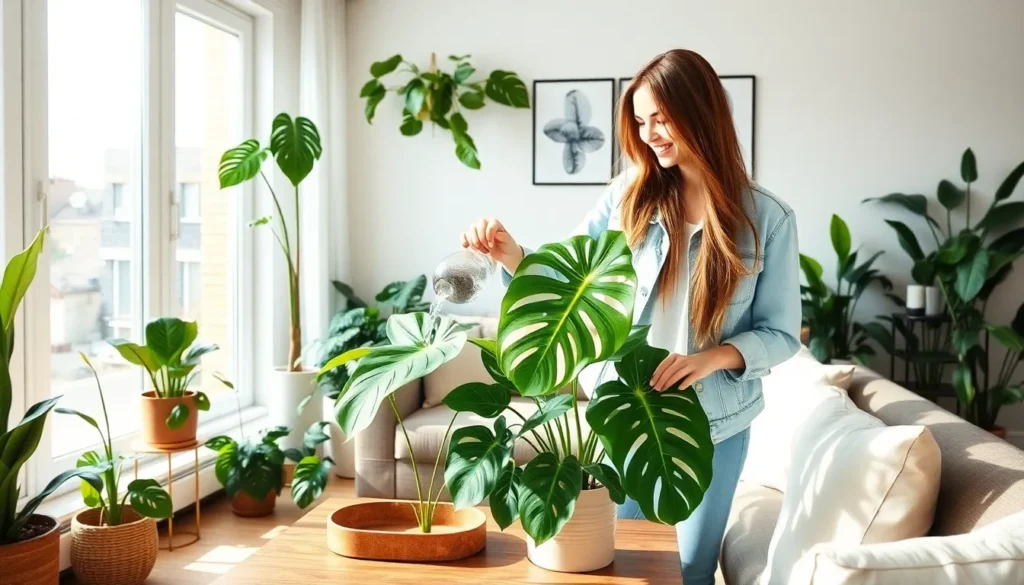Plants aren’t just beautiful additions to our homes – they’re powerful design tools that can completely transform any space. Whether you’re dealing with a cramped studio apartment or a spacious living room, incorporating greenery into your decor creates an instant connection to nature while purifying the air we breathe.
We’ve all walked into a room filled with lush plants and felt that immediate sense of calm and vitality. There’s something magical about how a simple fiddle leaf fig can make a corner come alive, or how trailing pothos can soften harsh architectural lines. The best part? You don’t need a green thumb to create stunning plant-filled spaces.
From dramatic statement plants that serve as living sculptures to tiny succulents that add charm to shelves and windowsills, we’ll show you how to use plants as the ultimate decorating secret weapon. Get ready to discover how the right greenery can make your space feel more luxurious, peaceful, and undeniably Instagram-worthy.
Choose the Right Plants for Your Room’s Lighting Conditions
Matching plants to your room’s natural light levels ensures healthy growth and stunning visual impact. We’ll explore the best plant options for every lighting scenario in your home.
Low-Light Plants for Darker Spaces
Snake plants thrive in dimly lit corners and require minimal water, making them perfect for beginners who want foolproof greenery. Their upright, architectural leaves add vertical interest to dark hallways, bathrooms, or basement spaces.
ZZ plants tolerate neglect while producing glossy, waxy leaves that reflect available light back into the room. These hardy specimens work exceptionally well in offices, bedrooms, or any space with north-facing windows.
Pothos vines cascade beautifully from shelves or hanging planters, creating flowing green curtains that soften harsh room angles. We recommend the golden pothos variety for its ability to brighten darker spaces with variegated yellow and green foliage.
Peace lilies produce elegant white blooms even in low light conditions, adding sophisticated floral elements to shadowy room corners. Their dark green leaves create dramatic contrast against light-colored walls or furniture pieces.
Bright Light Plants for Sunny Rooms
Fiddle leaf figs command attention as statement pieces in bright living rooms, reaching heights of 6-10 feet with proper care. Their large, violin-shaped leaves create bold focal points near south-facing windows or glass doors.
Monstera deliciosa develops stunning split leaves when placed in bright, indirect sunlight, making them ideal for modern dining rooms or entryways. These Instagram-famous plants can span 3-4 feet wide, filling empty corners with tropical drama.
Bird of paradise plants bring exotic flair to sun-drenched spaces with their paddle-shaped leaves and occasional orange blooms. We suggest positioning these 5-6 foot specimens near patio doors where they receive ample morning light.
Rubber trees offer glossy, burgundy-tinged foliage that creates striking silhouettes against bright white walls. Their tree-like structure works perfectly in high-ceiling rooms with abundant natural light sources.
Medium Light Plants for Versatile Placement
Dracaena varieties adapt to various lighting conditions while providing colorful striped leaves in shades of green, yellow, and red. These compact plants fit seamlessly on side tables, plant stands, or grouped arrangements throughout your home.
Chinese evergreens display beautiful patterned foliage in silver, pink, and green combinations that complement any color scheme. Their bushy growth habit makes them excellent choices for coffee tables or floor displays in moderate light areas.
Boston ferns create lush, feathery textures that soften modern furniture lines while thriving in consistent, moderate lighting. We love using these classic plants in hanging baskets or on pedestals to add movement and organic shapes.
Philodendrons offer heart-shaped leaves in various sizes and colors, from deep emerald to lime green varieties. Their trailing or upright growth patterns work beautifully in bedrooms, living rooms, or any space with east or west-facing windows.
Select Plant Containers That Match Your Interior Design Style
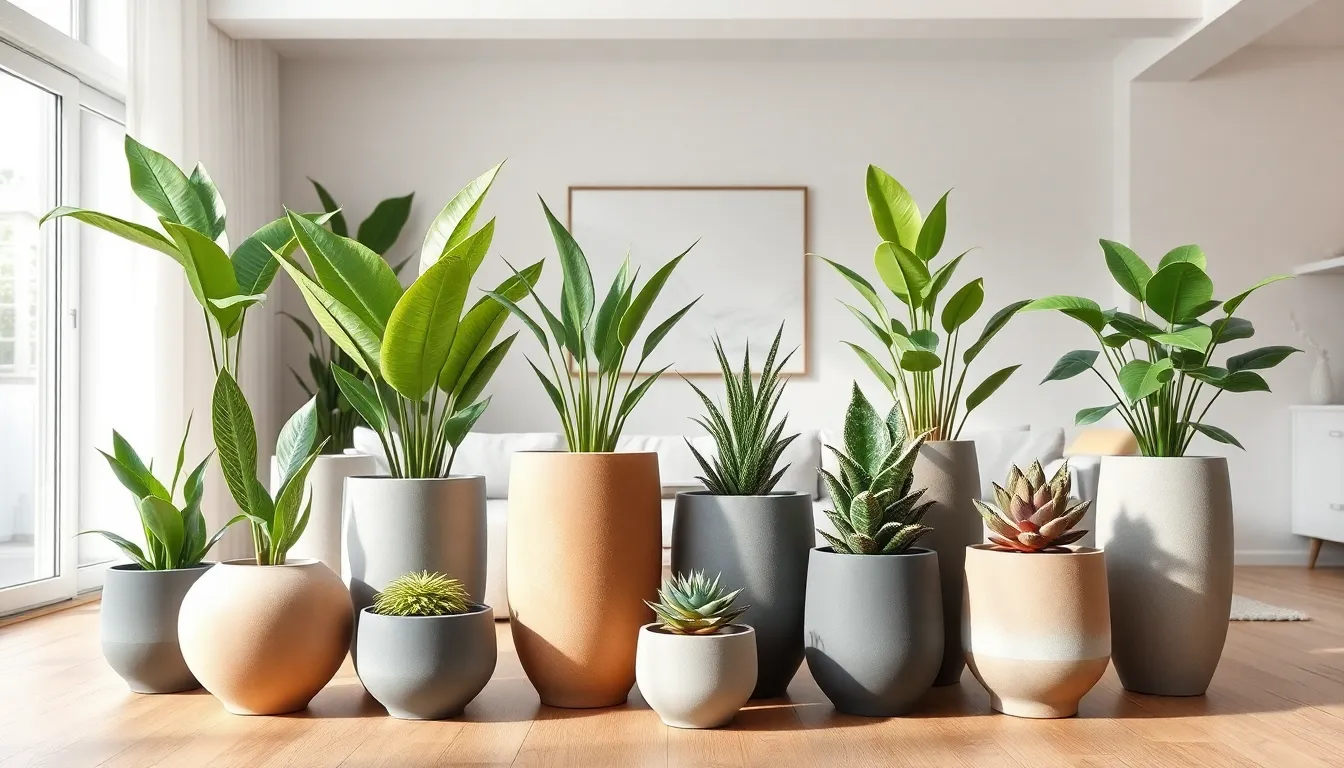
Now that we’ve chosen the perfect plants for our lighting conditions, we need containers that harmonize with our interior design aesthetic.
Modern Minimalist Planters
Modern minimalist planters feature clean lines and geometric shapes that perfectly complement contemporary spaces. We recommend selecting containers in neutral colors like white, black, or grey to maintain the calm, clutter-free atmosphere that defines minimalist design. Materials such as matte ceramic, concrete, and metal work exceptionally well because they emphasize the plants themselves without overwhelming the decor. These sleek containers blend seamlessly into modern rooms while creating sophisticated focal points. Geometric shapes like cylinders, cubes, and rectangles enhance the architectural elements of contemporary interiors.
Rustic and Natural Containers
Rustic and natural containers bring warmth and texture to our plant displays through organic materials and handcrafted appeal. Terracotta pots offer timeless charm and pair beautifully with succulents and snake plants in farmhouse or cottage-style rooms. Woven baskets add cozy texture and work wonderfully with trailing plants or as covers for plain plastic pots. Wooden planters create authentic rustic vibes and complement the natural beauty of plants like pampas grass or leafy greens. Stone containers provide earthy sophistication and durability for both indoor and transitional outdoor spaces. These organic materials enhance the handcrafted, lived-in feel that defines rustic and boho aesthetics.
Colorful and Decorative Pots
Colorful and decorative pots transform plants into vibrant focal points that energize eclectic and maximalist interiors. Bright glazes and hand-painted designs add personality and artistic flair to any room arrangement. Patterned ceramics with intricate motifs create visual interest and can tie together various design elements throughout the space. We suggest grouping multiple colorful containers together to create a playful, lively atmosphere that celebrates bold artistic expression. These decorative vessels work especially well in spaces where we want our plants to serve as statement pieces rather than subtle accents.
Create Visual Interest with Different Plant Heights and Sizes
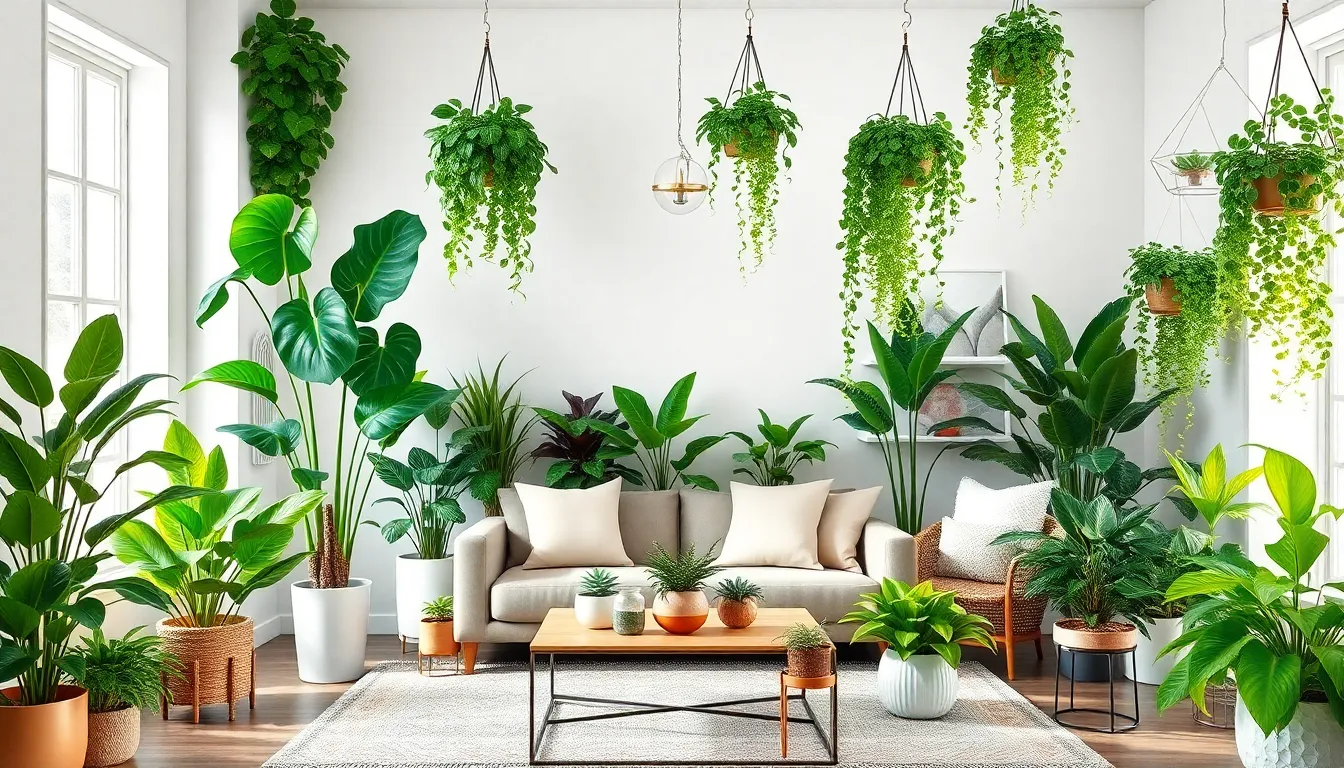
Layering plants at varying heights transforms flat spaces into ever-changing, multi-dimensional environments that capture attention and create visual depth. We achieve this dimensional effect by strategically combining tall statement pieces with medium-sized accent plants and smaller decorative greenery.
Floor Plants as Statement Pieces
Floor plants anchor our room’s design while creating bold focal points that draw the eye upward. Indoor trees like Fiddle Leaf Figs and Monstera Deliciosa provide towering foliage that makes smaller rooms feel more expansive and open. Large accent plants such as rubber plants or bird of paradise work exceptionally well near entryways, alongside furniture, or positioned under windows where they can make dramatic statements.
Positioning these substantial plants in awkward corners or empty spaces instantly adds life and fills visual gaps that traditional furniture can’t address. We recommend placing floor plants on wheeled plant caddies to make repositioning and maintenance much easier, especially given their considerable size and weight.
Tabletop Plants for Surface Decoration
Tabletop plants bring delicate greenery to eye level while complementing our larger floor pieces without overwhelming the space. Smaller varieties like succulents, cacti, small ferns, and flowering plants offer texture and freshness that enhance surfaces rather than cluttering them. These compact plants work perfectly on coffee tables, windowsills, office desks, and shelving units where they add natural beauty without demanding excessive space.
Grouping tabletop plants of different sizes creates mini-landscapes that serve as conversation starters while maintaining the room’s overall balance. We find that rotating seasonal varieties keeps our displays fresh and captivating throughout the year.
Hanging Plants to Use Vertical Space
Hanging plants maximize our vertical real estate while creating cascading effects that soften harsh architectural lines. Trailing varieties such as pothos, spider plants, and ivies can be suspended from ceiling hooks or wall mounts to bring lushness to eye level and above. This approach proves especially valuable in rooms with limited floor space where every square foot counts.
Suspended greenery adds movement and visual intrigue without encroaching on our floor or surface areas. We position hanging plants at varying heights to create layered canopies that transform ordinary rooms into lush, garden-like retreats.
Incorporate Plants into Specific Room Areas for Maximum Impact
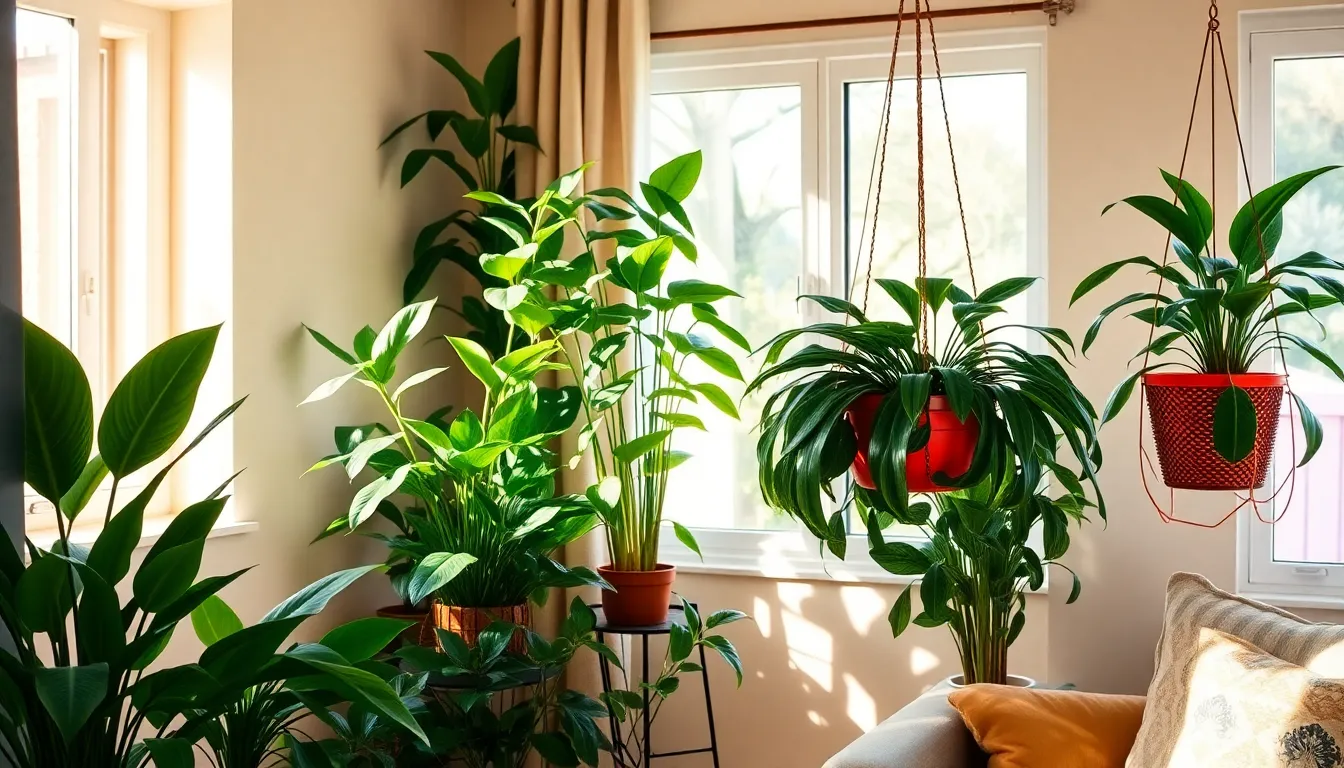
Different spaces in our homes present unique opportunities for plant placement, with each room requiring exact considerations for lighting, humidity, and functionality. We’ll explore how to maximize the decorative potential of plants in your most lived-in areas.
Living Room Plant Arrangements
Living rooms benefit from diverse plant styling that adds dimension, texture, and natural beauty to our gathering spaces. We recommend placing plants at different heights using stands, shelves, and hanging planters to create visual layers throughout the room.
Robust, low-maintenance plants like pothos, snake plants, ZZ plants, and peace lilies thrive in the indirect light common in living areas. These varieties require minimal care while providing maximum visual impact for busy homeowners.
Statement plants such as the Umbrella Plant (Schefflera), Areca Palm, and English Ivy enhance both visual interest and air quality in larger living spaces. We suggest positioning these larger specimens in corners or beside furniture pieces to anchor the room’s design.
Decorative containers transform ordinary plants into design elements that unify your overall aesthetic. Terracotta pots, vintage crocks, and quirky vessels add charm while maintaining visual coherence with existing decor.
Small corner spaces can accommodate vertical options like wall shelves or hanging planters, maximizing greenery without sacrificing floor space. We recommend styling with layers of plants and complementary accents like woven baskets or vintage trunks for an intentional, curated appearance.
Bedroom Plant Placement Ideas
Bedrooms gain tranquility and improved ambiance through strategic plant placement that promotes relaxation and better sleep quality. We suggest positioning plants on bedside tables or shelves away from direct sunlight to prevent leaf burn while maintaining easy care access.
Hanging planters near windows or in corners soften the bedroom space without creating surface clutter. These elevated arrangements add visual interest while preserving valuable nightstand and dresser space for essential items.
Air-purifying plants like snake plants and peace lilies actively improve indoor air quality during sleep hours. We recommend these varieties for their ability to release oxygen at night while requiring minimal maintenance.
Subtly fragrant plants such as lavender or jasmine enhance the bedroom’s relaxation potential through natural aromatherapy. Position these varieties where gentle air circulation can distribute their calming scents without overwhelming the space.
Kitchen and Bathroom Plant Options
Kitchens and bathrooms present unique growing conditions with higher humidity and varying temperatures that certain plants actually prefer. We’ve identified exact varieties that thrive in these environments while adding functional beauty.
Herbs like basil, mint, and rosemary are ideal for kitchen counters or windowsills, combining decorative appeal with culinary practicality. These edible plants provide fresh ingredients while adding natural fragrance and visual interest to cooking spaces.
Small succulents and air plants perform excellently in limited space conditions with irregular watering schedules. We recommend these varieties for busy kitchens where consistent plant care might be challenging.
Humidity-loving plants such as ferns and spider plants flourish in bathroom environments due to their preference for moist air. These varieties actually benefit from the steam and warmth generated by daily shower use.
Wall-mounted pots and hanging planters preserve valuable counter space while adding vertical greenery to functional areas. We suggest these space-saving answers for smaller kitchens and bathrooms where floor and surface space is at a premium.
Use Plants to Define and Enhance Different Zones in Open Spaces
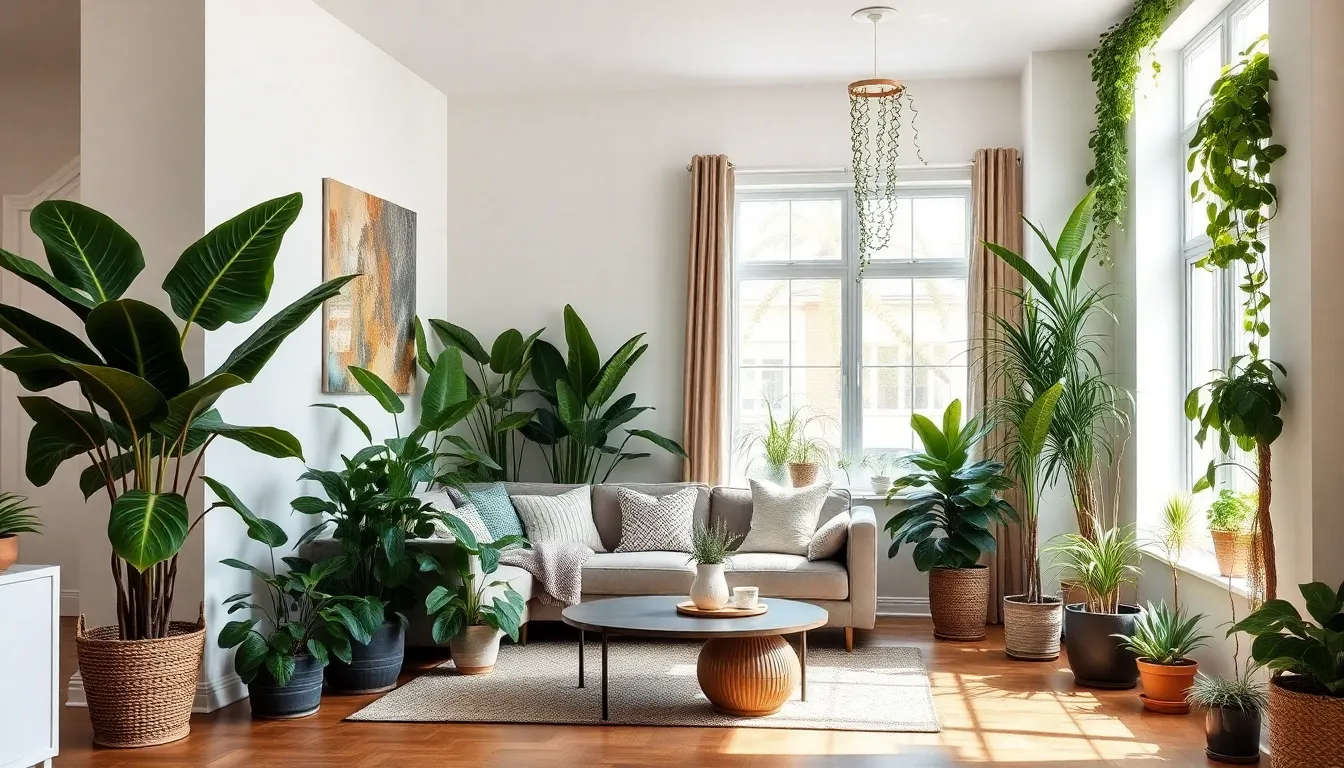
Open plan living requires creative answers to separate functional areas without sacrificing the spacious feel. Strategic plant placement serves as natural room dividers that enhance spatial flow while adding life to your interior design.
Room Dividers with Large Plants
Large leafy houseplants create effective living walls that partition rooms organically without harsh architectural lines. Fiddle leaf figs stand tall as statement dividers between living and dining areas, while monsteras add tropical flair to workspace boundaries. Palm varieties work exceptionally well when clustered together to form natural barriers.
Position these plants in decorative floor planters to maximize their room dividing potential. We recommend placing them in a row or small groupings to create visual separation while maintaining an open atmosphere. Snake plants offer another excellent option for their upright growth pattern and low maintenance requirements.
Height variation becomes crucial when using plants as dividers. Combine taller specimens with medium height plants to create layered boundaries that feel intentional rather than accidental. This approach adds depth while breaking up space visually without blocking natural light flow.
Corner Plant Groupings
Corner spaces often remain underutilized in room design, but plant groupings transform these areas into lush focal points. Combining plants of varying heights and leaf textures creates visual interest that draws the eye naturally to these previously empty spaces.
Start with larger floor plants as anchor pieces, then layer smaller specimens on plant stands or elevated surfaces. Rubber trees work beautifully as corner anchors, while pothos and philodendrons add trailing elements from raised positions. This layered approach maximizes vertical space while creating depth.
Texture mixing enhances corner plant displays significantly. Pair broad leafed plants like peace lilies with spiky dracaenas or feathery Boston ferns to create ever-changing contrasts. We suggest using odd numbered groupings (three or five plants) for the most visually pleasing arrangements.
Consider the lighting conditions in each corner when selecting plants. ZZ plants and cast iron plants thrive in darker corners, while brighter corners can accommodate fiddle leaf figs or bird of paradise plants.
Window Sill Plant Displays
Window sills provide ideal growing conditions for compact plant displays that connect indoor and outdoor environments. Natural light availability makes these spaces perfect for plants that might struggle in other areas of your home.
Small potted plants work best for window sill arrangements. Succulents like echeveria and jade plants create stunning displays while requiring minimal maintenance. Herb gardens on kitchen window sills combine functionality with beauty, providing fresh ingredients while adding greenery.
Trailing plants near windows add vertical interest and soften harsh window frames. String of pearls and English ivy cascade beautifully from window mounted planters, creating living curtains that filter natural light. We recommend using hanging planters positioned slightly away from the glass to prevent leaf burn.
Seasonal rotation keeps window displays fresh throughout the year. African violets bloom beautifully in bright windows during winter months, while small flowering plants like miniature roses add color during spring and summer seasons.
Combine Plants with Other Decorative Elements
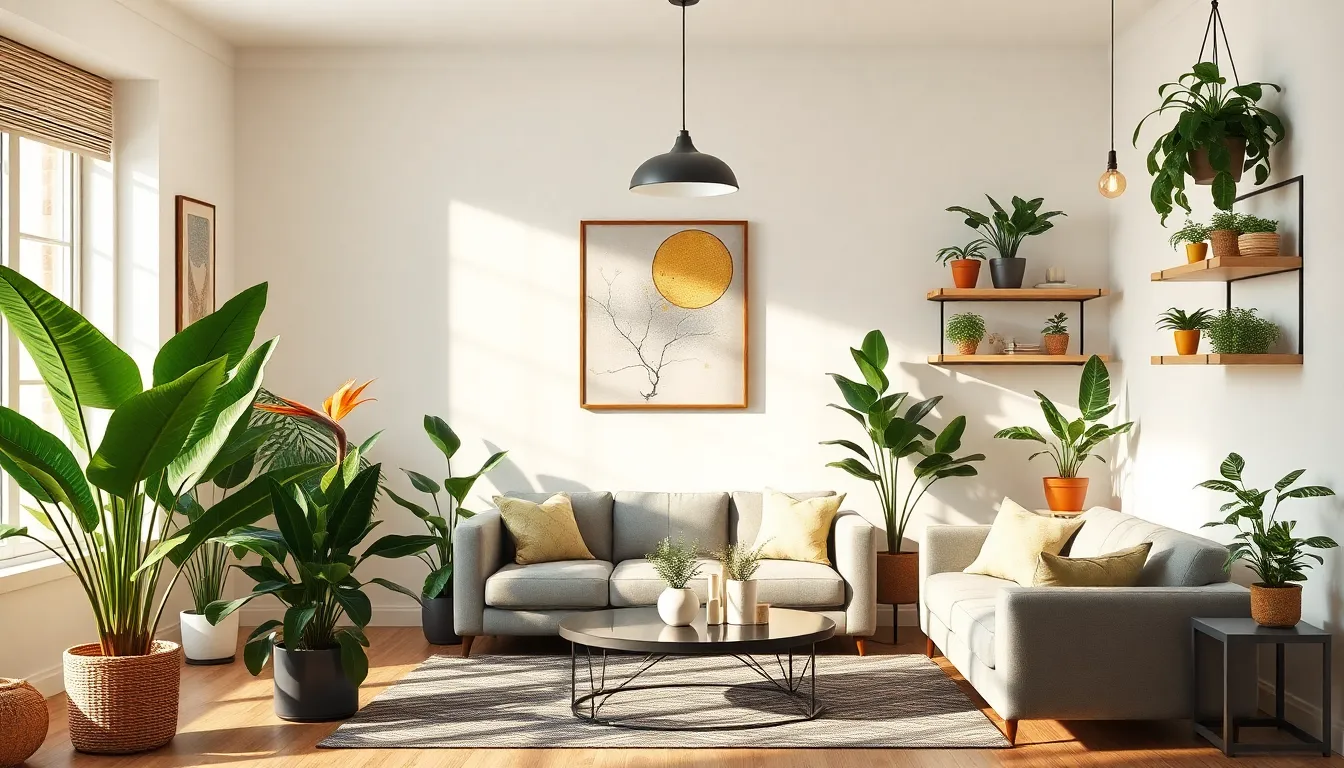
Pairing plants with other decorative elements creates harmonious interiors that blend nature with design. This approach not only decorates but also improves wellbeing by integrating greenery in ways that complement other decorative elements.
Plants with Artwork and Wall Decor
Plants complement artwork and wall decor by adding organic shapes and greenery that contrast or harmonize with visual elements on walls. Dried greenery or flowers can be hung decoratively on bedroom walls to create natural and textural backdrops that enhance the overall aesthetic. Large leafy plants like Bird of Paradise or Peace Lily positioned near murals or wall art soften hard architectural lines while adding living elements that complement structural design.
Gallery walls become more ever-changing when we incorporate small potted plants on floating shelves between framed pieces. Trailing plants like pothos or philodendrons create beautiful cascading effects that bridge the gap between wall mounted artwork and floor level furniture. Wall mounted planters add dimensional interest while preserving floor space in smaller rooms.
Plants with Furniture and Textiles
Plants paired with furniture and textiles create cozy, inviting spaces that feel warm and lived in. Leafy plants such as Bird of Paradise help warm neutral palettes and structured furniture with their organic shapes and fresh greenery. Textured bedding and cushions in natural fabrics combined with plants enhance room serenity and comfort throughout the space.
Strategic plant placement acts as living dividers in open plan spaces, creating subtle boundaries between furniture zones while maintaining airflow and light. Corner arrangements featuring multiple plants of varying heights transform unused spaces into lush focal points that complement seating areas. Plants placed on side tables, coffee tables, and nightstands add natural texture that balances hard furniture surfaces.
Plants with Lighting Fixtures
Natural or warm artificial light accentuates the lushness of indoor plants, increasing their visual impact and vitality throughout the room. Hanging plants in macramé planters positioned near light sources add vertical interest and diffuse light softly around the space. Self watering planters with integrated lighting answers represent emerging trends that combine plant care with decorative illumination for practical and aesthetic benefits.
Pendant lights positioned above large floor plants create dramatic shadows and highlight interesting leaf patterns on walls. Table lamps placed near plant groupings provide focused illumination that showcases texture and color variations in foliage. String lights woven through larger plants or wrapped around planters add warm ambient lighting that creates cozy evening atmospheres.
Maintain Your Room Decor with Plants Through Proper Care
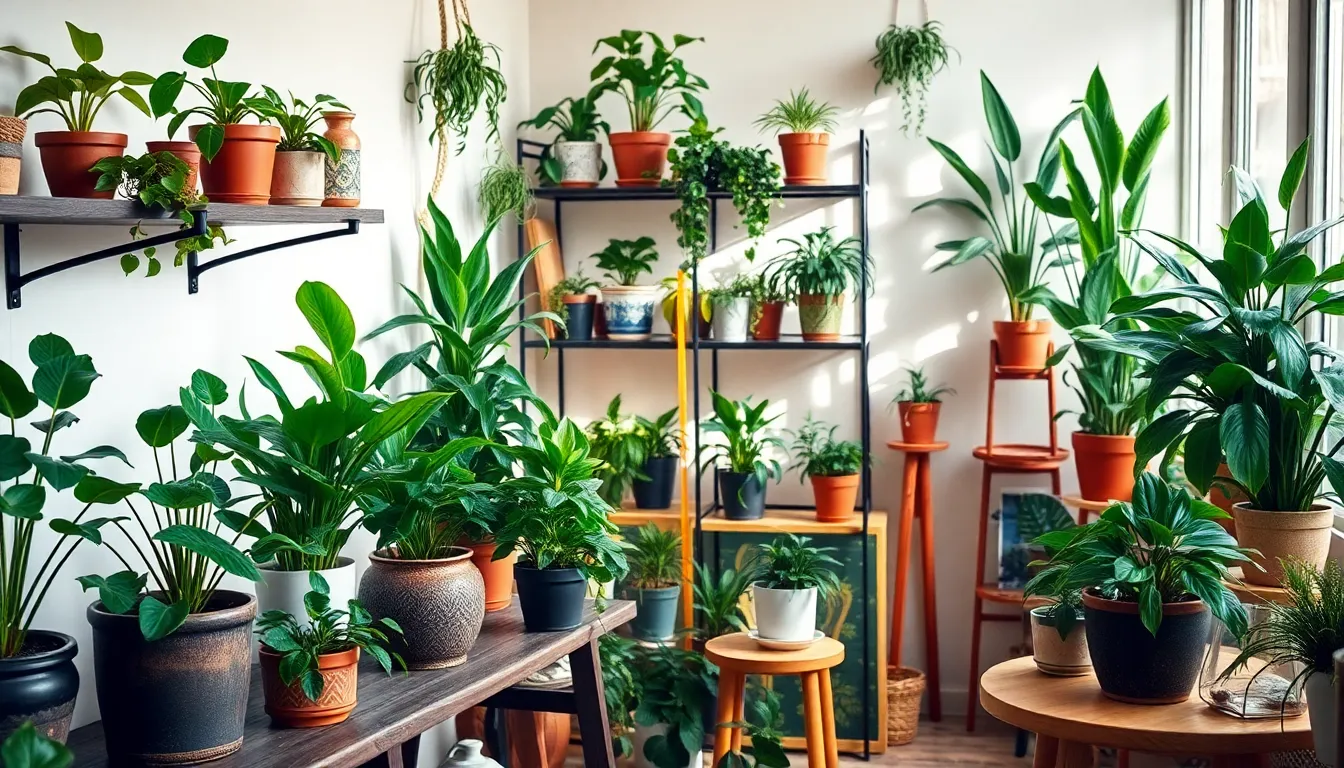
Proper plant care transforms your beautiful room decor into a thriving, long-lasting investment that continues improving your space. We’ll show you how to keep your plants healthy and vibrant while maximizing their decorative impact.
Watering and Feeding Schedules
Watering frequency depends on checking soil moisture rather than following strict schedules. Insert your finger into the soil about one inch deep to assess moisture levels. Plants need water when the top inch feels dry to the touch, preventing the overwatering that kills more houseplants than drought.
Fertilizing supports healthy growth during active growing seasons from spring through summer. Use balanced, water-soluble fertilizers to provide essential nutrients your plants need. Dilute fertilizer to half the manufacturer’s recommended strength to prevent root burning and chemical damage.
Different plant types require varying feeding schedules based on their growth patterns. Fast-growing plants like pothos and spider plants benefit from monthly feeding during growing season. Slow-growing varieties such as snake plants and ZZ plants need fertilizer only every 2-3 months.
Pruning and Grooming Tips
Regular pruning maintains your plants’ attractive shape while promoting vigorous new growth. Remove dead, yellowing, or damaged leaves immediately to prevent disease spread throughout your plant collection. Sharp, clean scissors or pruning shears ensure clean cuts that heal quickly.
Grooming keeps your decorative plants looking their absolute best in your room displays. Dust accumulates on leaves and blocks light absorption, reducing photosynthesis efficiency. Use a soft brush or damp cloth to gently clean leaves every few weeks.
Pinching growing tips encourages bushier growth patterns that enhance visual appeal. Plants like coleus and impatiens respond well to regular pinching of new growth tips. This technique creates fuller, more attractive specimens that fill decorative containers beautifully.
Seasonal Plant Care Adjustments
Spring and summer care intensifies as plants enter their most active growing periods. Increase watering frequency as higher temperatures and longer daylight hours boost plant metabolism. Plants consume more water and nutrients during these warmer months when growth accelerates.
Fall and winter adjustments prevent common cold-weather plant problems in heated indoor spaces. Reduce watering schedules significantly since plants grow much slower in shorter daylight conditions. Lower light levels and cooler temperatures naturally decrease water uptake and nutrient needs.
Humidity management becomes crucial during heating season when indoor air dries considerably. Maintain humidity levels between 40% and 60% using humidifiers, pebble trays, or plant groupings. Dry air stresses tropical plants and can cause leaf browning or dropping that ruins your decorative displays.
Conclusion
We’ve explored how plants can completely transform your living spaces through thoughtful selection placement and care. By matching plants to your room’s lighting conditions and choosing containers that complement your decor style you’ll create environments that feel both vibrant and harmonious.
Remember that successful plant decor isn’t just about aesthetics—it’s about creating sustainable green spaces that thrive in your home. With proper watering schedules seasonal adjustments and regular grooming your plants will continue to enhance your rooms for years to come.
Start small with one or two plants in key areas then gradually expand your collection as you gain confidence. Your home will thank you for the fresh air improved ambiance and natural beauty that only plants can provide.
Frequently Asked Questions
What are the benefits of using plants in home decor?
Plants bring calming and revitalizing effects to any space while adding natural beauty and life to rooms. They can soften harsh architectural features, improve air quality, and make spaces feel more luxurious and visually appealing. Plants also serve as effective design tools that can transform both small apartments and large living areas.
How do I choose the right plants based on lighting conditions?
For low-light areas, choose snake plants or peace lilies. Bright light spaces work well with fiddle leaf figs and monstera deliciosa. Medium light conditions are perfect for dracaena and Boston ferns. Match your plant selection to your room’s natural lighting to ensure healthy growth and maximum visual impact.
What types of plant containers should I use for different interior styles?
Modern minimalist spaces benefit from sleek, simple planters. Rustic interiors pair well with natural materials like woven baskets or terracotta pots. For colorful decorative styles, choose vibrant or patterned containers that complement your existing color scheme and add personality to the space.
How can I create visual interest with different plant sizes and heights?
Layer plants at varying heights using floor plants as statement pieces, tabletop plants for surface decoration, and hanging plants to maximize vertical space. This layering technique transforms flat spaces into dynamic environments and creates depth throughout your room design.
Which plants work best in specific rooms like bedrooms and bathrooms?
Bedrooms benefit from air-purifying plants like snake plants or pothos that promote relaxation. Bathrooms with higher humidity are ideal for ferns, orchids, or peace lilies. Kitchen spaces work well with herbs or small succulents that can handle varying temperatures and humidity levels.
How often should I water and care for my indoor plants?
Check soil moisture regularly and water when the top inch feels dry. Most plants need weekly watering, but this varies by species and season. Spring and summer require more frequent watering, while fall and winter need reduced care. Always adjust based on your specific plant’s needs.
Can plants help define different zones in open floor plans?
Yes, larger floor plants can effectively separate and define different areas in open spaces. Use tall plants to create natural room dividers or group smaller plants to establish cozy conversation areas. This technique helps organize large spaces while maintaining an open, airy feel.
What seasonal adjustments should I make for plant care?
Increase watering frequency during spring and summer growing seasons when plants are most active. Reduce watering in fall and winter when growth slows. During colder months, pay attention to humidity levels and consider using humidifiers to maintain optimal growing conditions for your plants.

